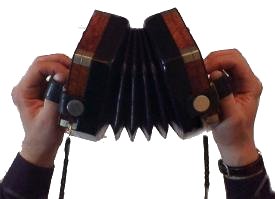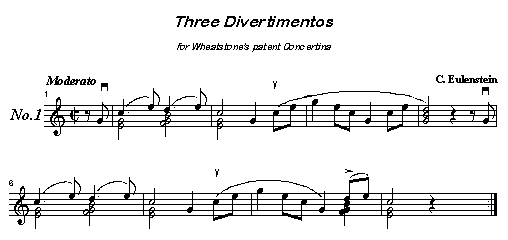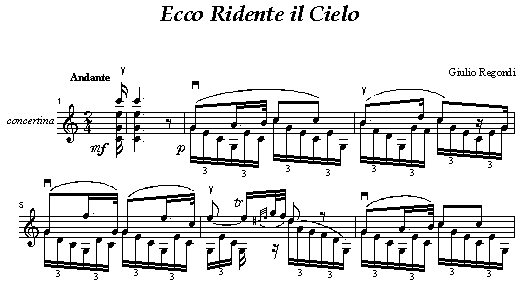|
Bellows
Technique
Basic Control and Movement
The famous German musician and composer Hugo Herrmann (1896-1967) once called
the bellows
of the accordion the 'soul' of the instrument. The bellows are
responsible for the quality of the tone,
articulation and phrasing. The bellows
on a concertina, belonging to the same family of bellows driven
instruments,
have exactly the same function as on an accordion.
Tone production is always one of the main points of attention on every
musical instrument. String
players spend years developing their bowing skills,
wind instrument players are always working on
their embouchure, pianist on
their touché, etc.. (Schooled) accordionist are aware of the possibilities
and
the importance of bellows technique and have a selection of methods available
concerning this
subject. Concertinist however, are not always able to obtain
the information necessary to develop
these important skills. This section,
basic control and movement, explains the basics.
The main objectives in bellows technique are:
- stability of the instrument
- maximum control over tone forming
Why stability
Stability is necessary in order to have any form of control over the
bellows. You can compare it
with writing. When you write, you keep your arm and
hand on the surface of the table. This allows
you to perform even the smallest
movements of your hand and fingers. You could call the table
your arm support.
Now lift up your arm. The only contact you now have with the table is through
the pen on the paper. I am sure you'll find it a lot harder to perform those
small movements without
any support.
This same principle applies to the bellows of the concertina (and all other
instruments with bellows).
If you hold the instrument up in the air without
touching anything, it is almost impossible to
completely control the bellows.
You'll hear every movement you make with your hand and fingers.
When you put the instrument on your knee, you'll notice that touching something
(in this case your
knee) helps you to control the movement, just like with
writing.
Creating a bellows support is essential
for controlling the bellows movement,
and therefore the tone forming.
Bellows support
On all instruments with bellows, we create a bellows support by keeping
one side of the bellows
closed (the ends touch). On accordions this is the
bottom of the instrument. The bellows are placed
on the (left) leg, which acts
as the pivot point. We need a pivot point because the bellows move.
Because of the size of the concertina and the fact that it is best played in a
standing position (see
"Holding the instrument 1: Instrument control"), we use
the lower front side as a pivot point. The
reason why we use this pivot point,
and not for instance the bottom side, is the angle of the arms.
If you hold your
hands in front of you, as you would when playing on a concertina, you'll see
that
your lower arms form a "V", because your body is wider than the concertina.
When you continue this
"V" through the concertina, the front of the bellows will touch. Your arm should always form one
line with the ends of the concertina.

The players point of view: the arms/hands and ends
form a "V", which creates the bellows support.
Bellows movement and the
"V" support
Bellows movement can be divided in periodical movement and
phrase movement. For now we will limit
ourselves to the first and least
complicated form.
Periodical bellows movement simply divides the music into even parts, following
the structure of
the music. If the music is not too complicated, periodical
movement is often the best way to deal
with the bellows. Because (most) tonal
music is symmetrical, we can decide on forehand where we
want change the bellows
direction. You should not be able to hear the change of direction. Just like
you
do not hear a wind instrument player or singer gasp for air between the notes.
The place you
chose depends on the structure of the musical phrase. Musical phrases normally are 8 measures long,
consisting of two 4 measure
sections. Depending on tempo, dynamics, number of bellows folds, air
consumption
of the instrument etc., the bellows change every 1, 2 or 4 measures.
To indicate the bellows changes in the score we use standard symbols. The first
symbol indicates
expanding and the second symbol (V) closing of the bellows

In this example changing bellows direction after every measure might
be another option, because of the symmetry of the musical phrase.
Because the moment of bellows changes are related to the symmetry of the
musical phrase, the
length of the expansion of the bellows musically required is
usually limited. Just like wind instrument
players take a new breath whenever
musically possible. They don't keep blowing until their lungs
are completely
empty. Another reason to limit the bellows expansion is the bellows support.
The "V" support is only possible when the bellows are partly expanded. If they
are expanded further
you loose the support and the ability to fully control the
tone forming. When more air consumption
is required, for instance with chord
playing, only the first part of the phrase can be played with the
bellows
support. This shows the limitation of periodical bellows movement and the need
for phrase
movement. Other variables, which will be discussed later are
dynamics, finger and bellows articulation.
Although Technically more demanding, the following examples can still be
played with periodical
bellows movement.


During the 19th century concertinas usually had only 4 fold bellows. Because of
the high standard
of the playing technique they did not need more folds.
|


